Huntington Bank Field
| Capacity | 67 000 |
|---|---|
| Country | United States of America |
| City | Cleveland |
| Clubs | Cleveland Browns |
| Category | Design awaiting implementation |
| Cost | $2.4 B |
| Construction | 2026–2029 |
| Design | HKS Architects |
Advertisement
Huntington Bank Field – design description
What are the key details of the new stadium project for the Cleveland Browns?
The construction of a new stadium for the NFL team, the Cleveland Browns, is planned for the southwestern suburb of Brook Park, near the international airport and a major highway interchange. The design was unveiled in August 2024 and was created by one of the most renowned architectural firms, HKS Architects.
The site earmarked for the investment was formerly occupied by Ford's factories, where, among other things, the legendary V8 engines used in models such as the Mustang were manufactured. The design of the new stadium refers to the industrial character of the place – its original architecture is intended to resemble a production plant.
The facility will take on a complex, irregular form, and the roof will consist of many plane surfaces with different angles of inclination. The walls and roof will be covered alternately with transparent material or dark panels, and large multimedia screens will be installed above the main entrances.
One of the most important features of the stadium will be its full roofing. The main segment of the roof, above the stands and the field, will be made of a transparent ETFE coating.
Inside, the facility will accommodate 67,000 spectators, roughly the same as the current Browns stadium, located in downtown Cleveland. A distinctive feature will be the stand behind the northeast end zone, known as the Dawg Pound, which will be the heart of the matchday atmosphere and will be equipped with a solution familiar from soccer stadiums – safe standing room.
The construction of the stadium is expected to cost $2.4 billion, which will make it one of the most expensive stadiums in the world. The Browns intend to finance half of the investment with private capital and half with public funds. If everything goes according to plan, the new stadium could be built between 2026 and 2029.
Who are the Cleveland Browns?
The Cleveland Browns are an American football team playing in the NFL, in the AFC North division. The team was founded in 1944 and first entered competition in 1946. The name of the team refers to Paul Brown, its co-founder and first coach. The Browns enjoyed their greatest triumphs in their early years, winning the last league championship in 1964.
In 1996, the team was effectively relocated to Baltimore (taking the name Baltimore Ravens) after a controversial decision by its then-owner, Art Modell. As part of a compromise, however, a new NFL team was to be formed in Cleveland within a few years to continue the Browns' tradition, and the city was to build a new stadium for it.
The old Cleveland Stadium was demolished in late 1996 and early 1997. The new Cleveland Browns stadium, which was built in its place, opened in 1999, and the re-created Browns team rejoined the league at that time. Since 2012, the Browns have been owned by entrepreneurs Jimmy and Dee Haslam.
Where do the Cleveland Browns currently play?
The current Cleveland Browns stadium was opened in 1999 and is located in the heart of Cleveland, on the shores of Lake Erie. The facility is designed for football (unlike its predecessor, which also hosted baseball games) and can seat approximately 67,000 spectators.
How did the plans to build a new stadium for the Cleveland Browns come about?
The Cleveland Browns' stadium lease expires after the 2028 season. The Browns' owners began considering a long-term strategy and possible scenarios after 2028 as early as 2017. Options included remaining at the current facility and modernizing it, as well as building a new stadium in a different location.
Since 2022, there has been increasing speculation in the media about the future of the Browns stadium. In February 2024, the NEOtrans blog reported that the team intended to purchase 176 acres of land in the southwestern suburb of Brook Park, right next to Cleveland Hopkins International Airport.
When was the vision for the new stadium in Brook Park presented?
In May 2024, NEOtrans published the first, as yet unconfirmed, visualization of the new stadium to be built in Brook Park.
On August 1, 2024, Cleveland Mayor Justin Bibb sent a letter to the Browns' owners offering a $461 million contribution from the city toward the modernization of the existing facility. Under the agreement, the stadium lease would be extended for 30 years. This would mean that the Browns would abandon their plans to build a new facility.
On August 7, 2024, the Cleveland Browns sent a letter to their fans and officially presented visualizations of the new stadium to be built in Brook Park. The concept was developed by HKS Architects, one of the leading firms in the design of sports facilities.
At the same time, the Browns stated that the possibility of modernizing the existing stadium is still being seriously considered.
What are the pros and cons of building a new stadium in Brook Park?
A huge advantage of the new arena is its full roof, which would be extremely useful in Cleveland's cold climate. The facility would offer many more commercial opportunities and create the chance to host large events such as the Super Bowl or concerts by world-famous performers.
The construction of a new stadium would solve many transportation problems (85% of Browns fans come to games from outside Cleveland), as there is plenty of space in the area to build sufficient parking spaces, and the site is located near a major highway interchange, an international airport, and is served by a rapid transit line (RTA Rapid Transit).
On the other hand, the current stadium is in a very attractive location, close to downtown Cleveland, on the shores of Lake Erie. However, the proximity of Cleveland Burke Lakefront Airport significantly hinders any possible expansion of the facility, including the construction of a full roof.
Who is for and against the construction of a new stadium in Brook Park?
Cleveland Mayor Justin Bibb is in favor of keeping the Browns in the downtown area. He has also ruled out the possibility of subsidizing the construction of a new stadium in Brook Park because the site is just outside the city limits. The Cuyahoga County authorities have also supported the renovation of the existing facility (instead of building a new stadium).
However, the Cleveland Browns prefer to build a new stadium and are consistently pursuing this goal. If they manage to resolve the financing issues, the Browns will build a new stadium in the suburbs. The Ohio state and Brook Park authorities have also supported this option.
What were the next steps towards the construction of a new stadium for the Cleveland Browns?
What will the new Cleveland Browns stadium be called?
On September 3, 2024, a sponsorship agreement was announced with Huntington Bank, based in Columbus, the capital of Ohio. Under the agreement, the existing Browns stadium was renamed Huntington Bank Field.
Although the 20-year agreement applies to the current Browns stadium in downtown Cleveland, if the team moves to Brook Park, the new stadium will bear the same name.
When was the partnership with the Lincoln Property Company announced?
A large development project costing approximately $1 billion is also planned on a 176-acre site in Brook Park, next to the stadium. On December 10, 2024, the Browns announced that Lincoln Property Company would be their partner in the project. Additional visualizations of the new stadium and the entire complex were also presented at the time.
What is the Cleveland Browns' plan to finance the construction of the new stadium?
The cost of building the stadium is estimated at $2.4 billion, which will make it one of the most expensive in the world. In February 2025, the Browns presented a financing model according to which half of the investment costs and any overruns are to be covered by private funds.
The Browns expect to obtain the remaining half ($1.2 billion), from public funds. Three entities would participate in the financing: the state of Ohio ($600 million), the city of Brook Park ($422 million), and Cuyahoga County ($178 million).
When did the Cleveland Browns acquire the land for the construction of the new stadium?
On June 24, 2025, the Browns finalized the purchase of 176 acres of land formerly occupied by Ford factories (specifically, the purchase was made by Primacy Development LLC, a company affiliated with Haslam Sports Group). The land was purchased for just over $76 million.
The land previously belonged to DROF BP I LLC, formed by developers Weston, Inc., DiGeronimo Cos. and Scannell Properties. The developers acquired the land in 2021 for $31.5 million with the intention of creating an industrial park.
When did Ohio state authorities decide to contribute to the cost of building a new stadium for the Cleveland Browns?
On June 25, 2025, the Ohio Senate and House of Representatives passed the 2026-2027 budget, which included $600 million for the Cleveland Browns to build a new stadium. On June 30, 2025, the budget was also approved by Ohio Governor Mike DeWine.
The money will be provided in the form of a grant and will come from the so-called unclaimed funds, which are fed by, among other things, forgotten bank accounts and unused checks that have become the property of the state of Ohio.
What changes in the law relevant to the Cleveland Browns did the Ohio authorities pass when granting the subsidy for the construction of the new stadium?
When the budget was passed, a change was also made to the so-called Art Modell Law, which is a law in Ohio that makes it difficult for professional sports teams to relocate. According to the amendment, this law will only apply if the team wants to leave the entire state, and not, as has been the case so far, the city.
This change significantly eases the situation for the Cleveland Browns, who are planning to build a new stadium just outside Cleveland's administrative boundaries – the previous regulations could have blocked or delayed this plan.
What is the significance of the Ohio authorities' decision to grant a subsidy for the construction of a new stadium for the Cleveland Browns?
The $600 million granted by the Ohio authorities in the form of a subsidy is a quarter of the total cost of building the stadium – exactly what the Cleveland Browns expected from the state. The decision taken by the Ohio legislature and governor is a significant step forward, bringing the investment much closer to fruition.
Shortly after the governor approved the decision, the owners of the Cleveland Browns issued a special letter of thanks, which was published on the team's website.
The next expected step is to secure over $400 million from bonds issued by the Brook Park city authorities.
Due to the skeptical stance of Cuyahoga County authorities towards the Browns' relocation plans, a financial contribution from the county – in the amount of $178 million, as requested by the club – seems unlikely. However, it is possible that the missing amount will be covered by additional private capital.
When will the new stadium for the Cleveland Browns be built?
The Cleveland Browns hope to begin construction of the stadium in early 2026, so that the investment could be ready for the start of the 2029 season, when the lease on the current facility is set to expire.
When is the development project around the new Cleveland Browns stadium supposed to be completed?
The first phase of the development project planned around the new stadium is also supposed to be completed by 2029. The first phase of this investment will include 576 apartments, 450 hotel rooms, and 233,000 square feet of retail space.
The second phase of the development project is to be completed by at least 2034 and includes the construction of a further 1,100 apartments, approximately 500,000 square feet of office space, another 450 hotel rooms, and 275,000 square feet of retail space.
What is the concept behind the new stadium for the Cleveland Browns?
What will the new Cleveland Browns stadium look like from the outside?
As the stadium is to be built near the airport, the structure cannot be too high, so it will be partially dug into the ground, with the playing field located 80 feet (over 24 m) below ground level.
The facility will take on a complex, irregular form, devoid of oval, rounded shapes. Its walls will rise vertically, and the roof will consist of multiple plane surfaces with varying angles of inclination.
The walls and roof will be covered alternately with transparent material or dark panels, and large multimedia screens will be installed above the main entrances. One of the most important features of the stadium will be its full roofing. The main segment of the roof, above the stands and the playing field, will be made of a transparent ETFE membrane.
The stadium's glass roof echoes other buildings in Cleveland that have large pavilions with glass roofs, such as the Tower City Center shopping mall, the Cleveland Museum of Art, and the Health Education Campus.
However, the overall form of the building is intended to resemble a large industrial facility, referring to the factories that once existed and still partially exist in the area. The concept bears some similarities to another NFL stadium, U.S. Bank Stadium in Minneapolis, also designed by HKS Architects.
What will the interior of the new Cleveland Browns stadium look like?
The stadium's stands will be divided into several tiers, with uneven spacing between them. The stands will have a capacity of 67,000 spectators, similar to the Browns' current facility. Spectators will be able to take advantage of numerous premium options and a wide range of catering services.
The most distinctive stand will be the one behind the northeast end zone, called the Dawg Pound. The name is a reference to tradition – it was the name given to one of the stands at the old Cleveland Stadium, which has been recreated in a sense at the new stadium, opened in 1999.
The new Dawg Pound is to be the heart of the Browns fans' support. The stand will be extremely steep and will offer a solution known from soccer stadiums – safe standing areas.
The stadium will be equipped with impressive event lighting and other modern systems and technologies that will enable spectacular choreography and enhance the spectator experience. Inside, there will be two large, elongated video screens located in the end zones.
What is planned for the area surrounding the new Cleveland Browns stadium?
A large development project is planned next to the stadium, which will include new apartments, hotels, offices, and shops, as well as a Browns team store and museum.
Among the commercial facilities, there will be wide promenades, while a large square will be built on the south-western side of the stadium. In addition, 14,000 parking spaces are planned around the arena.
Where will the new Cleveland Browns stadium be built?
The stadium is to be built in the southwestern suburb of Brook Park, just outside the administrative boundaries of Cleveland, about 10 miles (16 km) from the center of the metropolitan area. The entire plot, which will also include a development project and new parking lots, covers an area of 176 acres.
The site selected for construction is located next to Cleveland Hopkins International Airport and the I-71 and I-480 highway interchange. The stadium will also be accessible by rapid transit (RTA).
What used to be located on the site where the new Cleveland Browns stadium is to be built?
The site was formerly occupied by two large Ford industrial plants, a casting plant (opened in 1952) and an engine factory (Cleveland Engine Plant number 2, opened in 1955).
The casting plant produced cast iron engine blocks, but with the spread of lighter aluminum blocks, it lost its importance. It was closed in 2010 and the building was demolished two years later.
Cleveland Engine Plant number 2 (there was also Plant number 1 nearby, which is still in operation today) became famous in the late 1960s and early 1970s for producing the legendary 351 Cleveland V8 engine used in iconic muscle cars such as the Mustang and Torino. The plant was closed in 2012 and its buildings were demolished in 2021.
Advertisement
Renderings
-
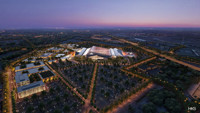
12.2024 © HKS Architects 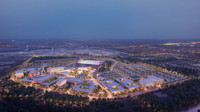
12.2024 © HKS Architects 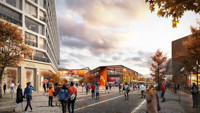
12.2024 © HKS Architects 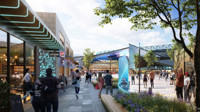
12.2024 © HKS Architects 
12.2024 © HKS Architects 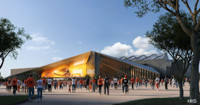
12.2024 © HKS Architects 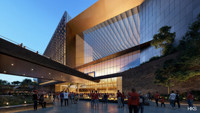
12.2024 © HKS Architects 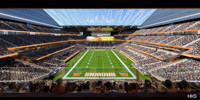
12.2024 © HKS Architects 
12.2024 © HKS Architects 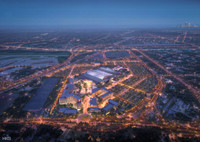
08.2024 © HKS Architects 
08.2024 © HKS Architects 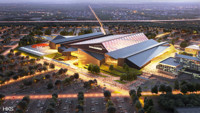
08.2024 © HKS Architects 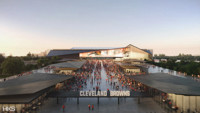
08.2024 © HKS Architects 
08.2024 © HKS Architects 
08.2024 © HKS Architects 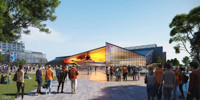
08.2024 © HKS Architects 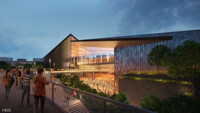
08.2024 © HKS Architects 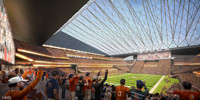
08.2024 © HKS Architects 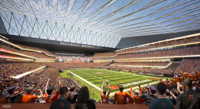
08.2024 © HKS Architects 
08.2024 © HKS Architects 
08.2024 © HKS Architects
08.2024:
Related news
2025
-
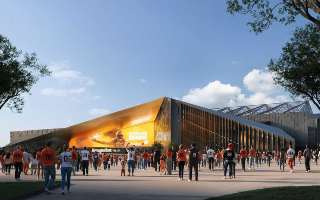
USA: Browns' dream of a new stadium blocked by the airport
Plans to build a domed Cleveland Browns stadium in Brook Park have hit a major obstacle. The Ohio Department of Transportation – after an intervention from Hopkins Airport, managed by the city of Cleveland – has refused to issue a building permit.
-
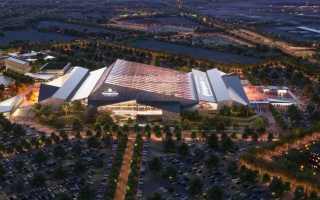
USA: Cincinnati Bengals staying in town as Paycor Stadium lease deal finalized
The Cincinnati Bengals and Hamilton County have signed a new lease agreement for Paycor Stadium. The conclusion of negotiations ends years of uncertainty and controversy surrounding the future of the stadium and its tenant.
-
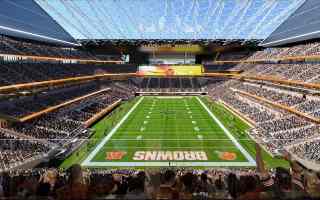
USA: Browns reveal details on ownership and financing of new stadium in Brook Park
The owners of the Cleveland Browns, Jimmy and Dee Haslam, have disclosed key details regarding the ownership, financing, and maintenance of the team’s new stadium, with construction expected to begin in early 2026 in Brook Park.
-
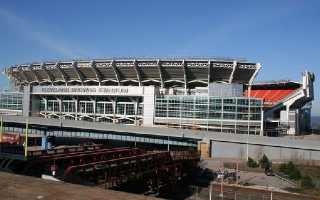
USA: Cleveland plans waterfront redevelopment... without the Browns stadium
Even though a legal fight aimed at keeping the Cleveland Browns in the city is still going on, Mayor Justin Bibb is still moving on with a new vision for the lakefront—one that does not include the team’s current stadium, Huntington Bank Field.
-
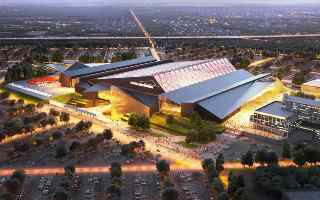
USA: Battle over Cleveland Browns’ move to Brook Park heats up
For Ryan James, co-owner of the Flat Iron Cafe – Cleveland’s oldest Irish pub – NFL game days are a true lifeline in an increasingly challenging business environment. “We open at 9 a.m., and within a few hours, both floors are packed with fans,” he says.
-
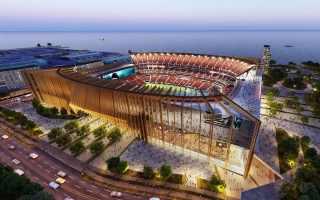
USA: Cleveland Browns’ dilemma over building a new stadium
The $2.4 billion project for the new Cleveland Browns stadium sparks controversy among residents and city officials. While the renovation of Huntington Bank Field is still considered, the club’s owners favor the new location in Brook Park.
 StadiumDB
StadiumDB